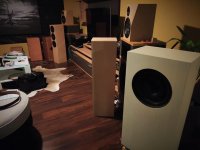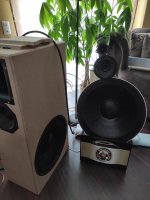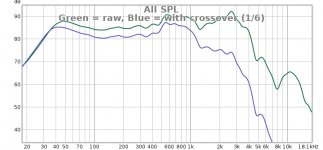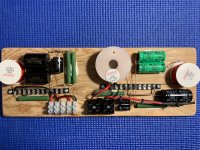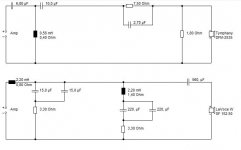tubeglow49 I don't want to hijack this thread and any horn building plans will have to wait till I'm finished my chemotherapy treatments. Thinking of 2 15" bass and the Sabourin horn with a 4" full range. Fully balanced system with Benchmark dac/pre and amp playing my favourite hard bop.
I really like the Weissbier speaker stand 🙂
While i'am waiting to start my build, i used some time to do one of the crossover's.
For the fun of it, and also because of my nonexperience into speakerbuilding i mocked up a quick measurement on one of the LaVoce big woofer's.
I just placed one of them on my desk, and placed my umik mic. ~15cm. from it.
- Not paying attention to line thing's right up, just a quick fun testmeasurement.
1. measurement was done with the RAW driver, second with the crossover attached to it, clearly showing that it dip's down around 1-2Khz or so with crossover attached 🙂
Again my nonexperience, i have to ask, what kind of filter/crossover is this ? (1. order / 2. order / 3. order or whatever)
Jesper.
While i'am waiting to start my build, i used some time to do one of the crossover's.
For the fun of it, and also because of my nonexperience into speakerbuilding i mocked up a quick measurement on one of the LaVoce big woofer's.
I just placed one of them on my desk, and placed my umik mic. ~15cm. from it.
- Not paying attention to line thing's right up, just a quick fun testmeasurement.
1. measurement was done with the RAW driver, second with the crossover attached to it, clearly showing that it dip's down around 1-2Khz or so with crossover attached 🙂
Again my nonexperience, i have to ask, what kind of filter/crossover is this ? (1. order / 2. order / 3. order or whatever)
Jesper.
Attachments
Electrically, it is 6dB with few impedance and frequency shaping circuits There is impedance flattening RC, then there is RLC that is rather low Q and flattens the frequency response. I'd use some high W resistors in parallel for RLC, say 3x10 ohm at least 10W in parallel.. And there is series capacitor of large value that flattens the hump in bass response and makes it go lower than it would in a cabinet of that size given that it is highish Qts woofer.
Acoustically, only measurement can tell.
Acoustically, only measurement can tell.
Last edited:
You were not rude, I was not clear in this last message either.
The Saturday night was aimed at Zvu😉
The Saturday night was aimed at Zvu😉
??
I see a third order on horn and second on woofer??
For it to be second order electrically, there should be coil in series and capacitor (without resistor) in parallel. This is RC circuit used here. Acousticaly it does some frequency shaping but electrically nomenclature for woofer crossover is 6dB/o band-pass filter with RC and an RLC.
Last edited:
You forget the coil in the driver 😉 it would be somewhere between a 1#st and 2nd order with a resistor as a load, but a driver isn’t a resistor....
It all boils down to a semantic meaningless exchange😉
Acoustical slope is what matters!
@rese66: You have it I suppose🙂
Acoustical slope is what matters!
@rese66: You have it I suppose🙂
It all boils down to a semantic meaningless exchange😉
Acoustical slope is what matters!
@rese66: You have it I suppose🙂
Agreed, but then why did you aim your question to me if it is meaningless semantics ?
Member asked a question, i answered what the crossover is electrically and that only measurements can tell the acoustic slope. You've obviously came to the same conclusion now.
Last edited:
I was not clear in this last message either.
I never thought of answering that question. Besides it's already Sunday night in here. 😀
Last edited:
Agreed, but then why did you aim your question to me if it is meaningless semantics ?
Member asked a question, i answered what the crossover is electrically and that only measurements can tell the acoustic slope. You've obviously came to the same conclusion now.
You're right, I did not read it correct.
@Rese Yes that horn with midrange and side firing woofer looks interesting. Are those oposite firing woofers or just a single side firing woofer. That was probably not easy to integrate. How did that sound?
Cheers W
Cheers W
Little mess around on the weekend...😀
Would love to know more about that coax.
Apart from the RCL correction and the large HP cap:
Whether it is a 2nd order crossover or a 1st order crossover plus correction is a matter of opinion. The two 15µF caps together result in 30µF and without the downstream resistor, it would be a classic 12dB filtering. The resistor is there to shape the filter a little.
The box on the left in the second picture with the side woofer is brand new from my friend Christian. The Faital Pro 18XL2000 is installed on the side and a Faital Pro W8N8-150 as a midrange. The Dayton AMT Pro 4 plays on the Beyma TLP-150 horn in the treble. The woofer plays on 100 liters / 3.5ft³ closed. Everything is driven by a 4-channel power amplifier with DSP and 250 watts each for the tweeter and mid-range speaker, as well as 1000 watts (2 channels bridged) for the woofer.
The set-up wasn't perfect yet. We only had one speaker to listen to because there was only one amp, but it was still a lot of fun.
The coax is a Sica 12 C 2.5 CP to which a Tymphany DFM 2535 is connected. It is built up passively, but is not finished yet.
Whether it is a 2nd order crossover or a 1st order crossover plus correction is a matter of opinion. The two 15µF caps together result in 30µF and without the downstream resistor, it would be a classic 12dB filtering. The resistor is there to shape the filter a little.
The box on the left in the second picture with the side woofer is brand new from my friend Christian. The Faital Pro 18XL2000 is installed on the side and a Faital Pro W8N8-150 as a midrange. The Dayton AMT Pro 4 plays on the Beyma TLP-150 horn in the treble. The woofer plays on 100 liters / 3.5ft³ closed. Everything is driven by a 4-channel power amplifier with DSP and 250 watts each for the tweeter and mid-range speaker, as well as 1000 watts (2 channels bridged) for the woofer.
The set-up wasn't perfect yet. We only had one speaker to listen to because there was only one amp, but it was still a lot of fun.

The coax is a Sica 12 C 2.5 CP to which a Tymphany DFM 2535 is connected. It is built up passively, but is not finished yet.
It seems like Sica is getting noticed in Germany in general. I was supposed to make a factory tour in spring, but covid crap stopped that!🙁
I have the SICA 6cx 2pl 8 + 8, it sounds promising in test boxes, but I have no materials for enclosures as bauhaus und weiter are closed here...
I have the SICA 6cx 2pl 8 + 8, it sounds promising in test boxes, but I have no materials for enclosures as bauhaus und weiter are closed here...
- Home
- Loudspeakers
- Multi-Way
- Asathor - a JBL 4367 Clone
